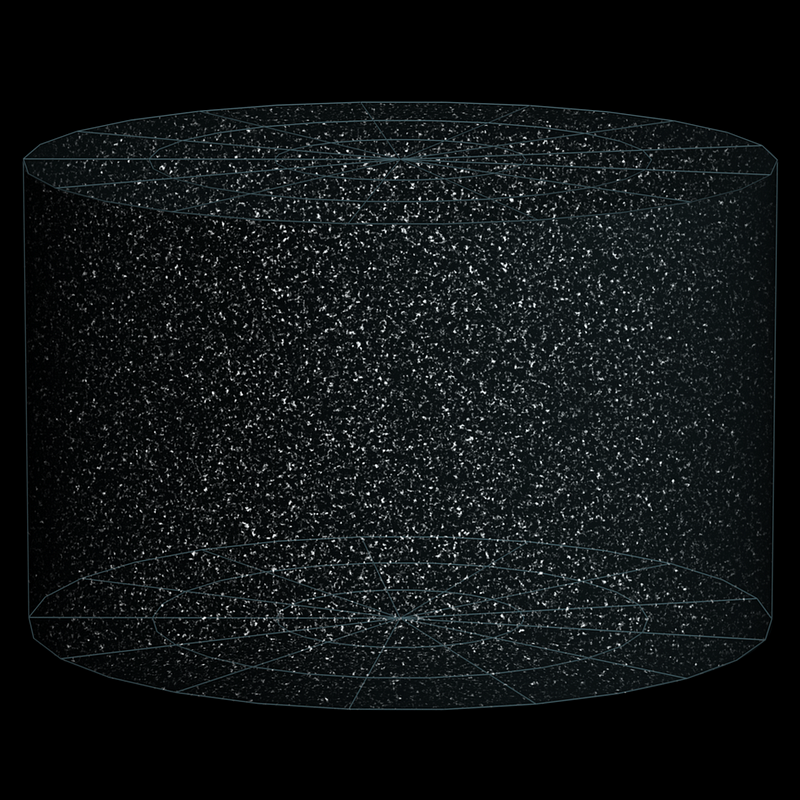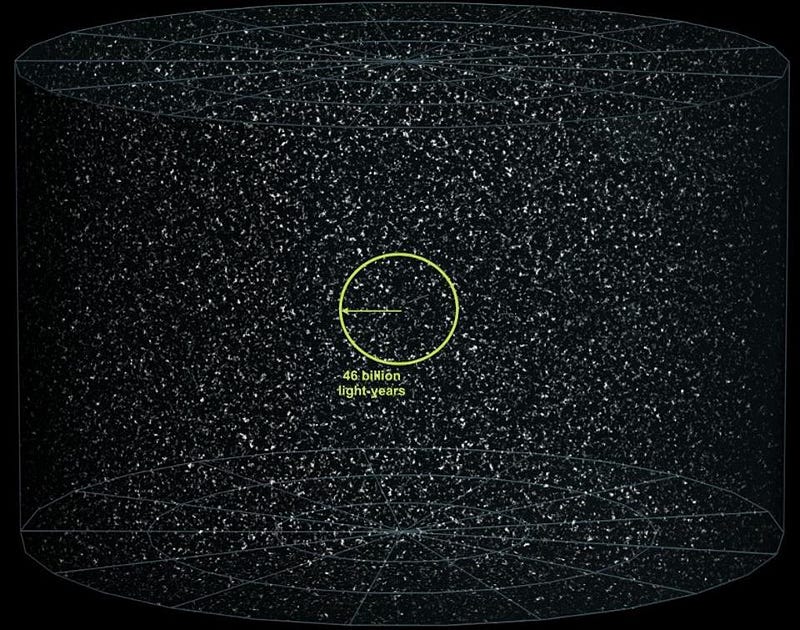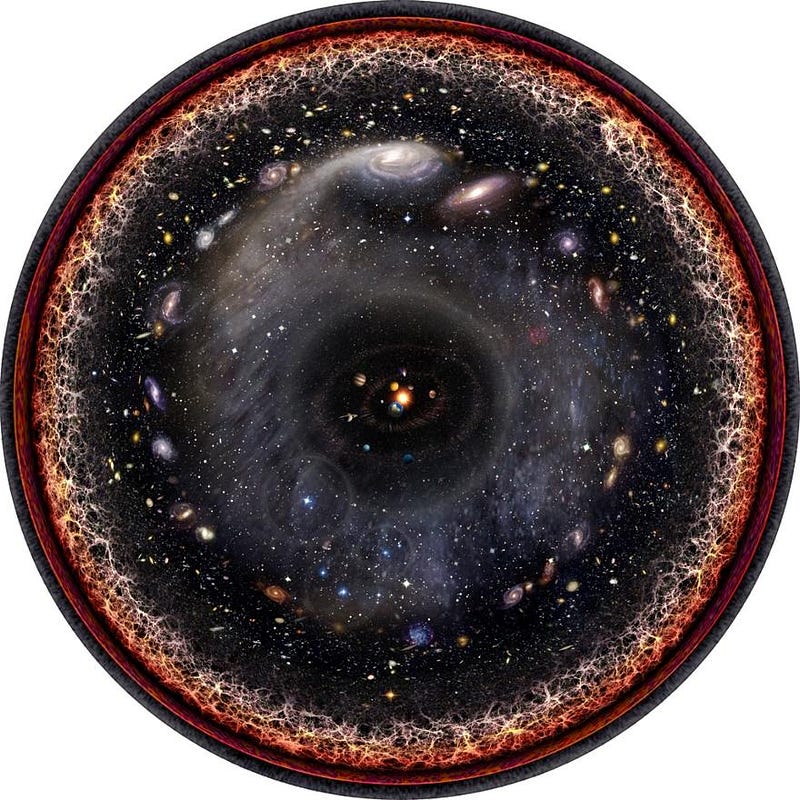Why Is The Sky Dark At Night?

The darkness of the night sky was a mystery for generations of humans. Here’s the reason why.
From our perspective here in the Solar System, it makes absolute intuitive sense why we see what we do at day versus night. During the day, sunlight floods our atmosphere in all directions, with both direct and reflected sunlight coming to us from everywhere we can see. At night, the sunlight doesn’t flood the atmosphere, and so it’s dark everywhere in the sky that there isn’t a point of light at, like a star, planet, or the Moon.
But you might start to wonder a little more deeply than that. If the Universe is infinite, shouldn’t our line-of-sight eventually run into a star no matter what direction we look in? Given that there are trillions of galaxies out there, and that telescopes that are capable of seeing the faint ones that our eyes cannot, why doesn’t the light from all of them combined illuminate every point on the sky? It’s not an easy question to answer, but science is up to the challenge.

This is a puzzle that’s troubled scientists for centuries. If you think about it deeply, it might not even make sense to you. Yes, it’s true that our atmosphere here on Earth is largely transparent to visible light, which is what enables us to see into the vast abyss of deep space at night. Our location in the galaxy means that only the galactic plane is obscured by the foreground dust and gas that blocks the light from the Milky Way’s central region.
But outside of that, you might expect to see light in every direction and at every location you were capable of looking in. After all, if the Universe is truly infinite, then the void of deep space goes on forever. In any direction you can imagine, eventually your line-of-sight will run into a shining point of light.

If this were true, then the night sky wouldn’t be dark at all, but would be lit up by every star whose light path made the long journey to the Earth.
Yet, even when we look to the deepest depths of what appears to be empty space, where no stars or galaxies can be seen by human eyes or even conventional telescopes, our most powerful observatories reveal so much that’s there, but it’s still just a few points of light against the black backdrop of empty space.
Yes, the Universe is full of stars and galaxies. Yes, they’re at enormous distances: millions, billions, or even tens of billions of light-years away. Starlight travels through the Universe and reaches our best observing equipment, revealing a rich Universe with an enormous extent. But enormous, no matter how large it gets, is a long, long way from infinite.

The jury, scientifically, is still out as to whether the Universe is finite or infinite; we simply don’t know. What we do know, however, is that the part of the Universe that’s observable to us must be finite. Even though we knew practically nothing about the large-scale structure of the Universe until the latter half of the 20th century, we still knew that an infinitely large observable Universe was simply an impossibility.
Back in the 1800s, Heinrich Olbers took note of a mathematical paradox. If you had an infinite Universe with a constant density of stars and/or galaxies, then you’d wind up seeing an infinite amount of light from every direction you’d look in. You’d see all the stars that were nearby, and then in the spaces between the stars, you’d see the stars farther away. In the spaces between those stars, you’d see even more stars that were at an increased distance. Regardless of the distance to them — millions, billions, trillions, quadrillions of light-years, etc. — eventually, wherever you looked, you’d run into a star.

Think about it mathematically, if you will. If the number density of stars is constant throughout space, then the total number of stars you’ll find is equal to the stellar density multiplied by the volume of the Universe. The farther away a star is, the fainter it appears: its brightness falls off as the inverse distance squared (~1/r²).
But the total number of stars you can see at a particular distance is related to the surface area of a sphere, which increases with the distance squared. (The formula for a sphere’s surface area is 4πr².) Multiply the number of stars by the brightness of each star, and you get a constant. The brightness a certain distance away is a particular value: let’s call it B. Twice as far away, that brightness is also B. Three times? Still B. Four? B again.

Now add up that series: B + B + B + B + ….. and so on. Can you see where this is going? The answer, unfortunately, is towards infinity. Unless there’s some cutoff to that series, you’ll get an infinite value for the brightness of the night sky in every direction.
Back in the 19th century, Olbers used this line of reasoning to conclude that the observable Universe could not be infinite, but he couldn’t be sure. After all, there were other astronomical concerns. One of the common objections was that this naive analysis didn’t take into account all the light-blocking dust that was clearly present, and which you could see just by looking at the plane of the Milky Way. Even in the modern day, many of our most famous astronomical sights are filled with light-blocking dust.

In a finite Universe, that dust can compete with starlight, as the visible light that strikes the dust gets absorbed and re-radiated at lower energies. But if the Universe were truly infinite, the problem of Olbers’ Paradox would show up for every dust grain out there: each grain would have to absorb an infinite amount of starlight, until it, too was radiating at the same temperature of all the light it absorbed!
In other words, something was off. Our Universe couldn’t be static, infinite, and filled with stars that shone forever. If this were the case, the night sky would be forever and eternally bright, in all locations and all directions. Clearly, something else is at work here.

The fact that saves us, which Olbers had no way of knowing back in his day, is not that the Universe isn’t infinite in extent (it still could be), but that it doesn’t go back, in its current form, for an infinite amount of time. The Universe we inhabit today had a beginning: a day without a yesterday. That beginning is known as the Big Bang, which puts a starting line for all the matter, radiation, energy, and light that possibly exists in the observable Universe.
The Universe hasn’t been around forever, and therefore we can only observe stars and galaxies that are a specific and finite distance away. Therefore, we can only receive a finite amount of light, heat, and energy from them, and there cannot be an arbitrarily large amount of light in our night sky.

But this brings up another piece to the puzzle. If the Universe were hot and dense and full of matter and radiation at some early time, like the Big Bang claims, then that early-time radiation should eventually make it to our eyes. Everywhere we look, in all directions, there should be no escaping that radiation.
In fact, based on modern day observations, we can actually calculate how many photons left over from the Big Bang are filling the Universe today, and the answer is 411 of them for every cubic centimeter of space. If you’re asking why we don’t detect it, the answer is that we do, and we do all the time. If you were to take a very old-style television, one with the rabbit-ear antennae, out into the depth of intergalactic space, away from any stellar or terrestrial radio sources, you could tune it to channel 3. You’d still see about 1% of the “snow” you see on Earth; that’s the radiation from the Big Bang.

The fact of the matter is that we do receive this light from the Big Bang, and that it’s found all over the sky in an unavoidable fashion. The only reason you don’t see it with your naked eye is because the Universe has expanded over the course of cosmic history, and so this once-visible light is now shifted to such long wavelengths that your eyes cannot see them, your skin cannot feel them, and your body cannot detect it.
But your microwave and radio antennae can pick them up. In fact, that’s how this radiation was first discovered, and how the Big Bang was first confirmed: with a giant radio antenna that picked this signal up, no matter when or where the scientists operating it were looking. If our eyes had adapted to see microwave or radio light, we would, in fact, see a night sky that was uniformly bright in every direction, with no dark spots anywhere.

It takes two facts, together, to explain why the night sky is dark. The first one is that the Universe has only been around for a finite amount of time, which limits the extent and amount of the radiation that’s presently observable to us. The second is that we can only see light in a limited part of the electromagnetic spectrum: the optical portion.
If we could, instead, view the sky in microwave light, the sky would appear bright in all directions at all times. It’s a little bit ironic, when you think about it, that it’s only our very human limitations that made the night sky look like an interesting place at all to explore. Today, we’ve built satellites designed to measure this radiation exquisitely, and they’ve taught us far more about the origin and properties of our Universe than we’d ever learn from using our limited senses alone. The night sky may seem dark to us, but the light that’s always there has taught us the ultimate resolution to this cosmic paradox.
Ethan Siegel is the author of Beyond the Galaxy and Treknology. You can pre-order his third book, currently in development: the Encyclopaedia Cosmologica.





